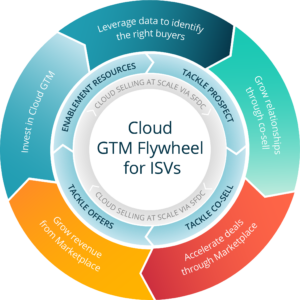Tackle’s CRO Don Addington on Tackle Prospect and The Power of Targeting the Right Buyers
I’m gonna date myself a little bit here, but it wasn’t so long ago that you could walk into a retail establishment—restaurant, grocery store, drug store—and they only offered a limited number of options for payment. It wasn’t unusual to ask: “You don’t take American Express?” or “Wait, I can’t use my Visa here?” Today, you can pay with almost any form of payment. Why? Convenience. As a shopper, I have options and if you can’t accept the form of payment I want to use, I’ll go elsewhere.
Is it surprising that software is following the same path? Let’s be clear, the act of purchasing software is still difficult. You have buying committees (so many opinions), you have internal vendor management, legal, and security (SO. MUCH. SECURITY). As a buyer, you are almost conditioned to avoid buying any software because it’s so damn painful. But everyone needs software. Software underpins almost everything we do in the business world and our buyers are looking for the easiest paths possible to purchase their software and get on with their lives.
Identifying buyers who prefer to purchase via the Marketplaces
Enter Cloud Marketplaces, like AWS, Microsoft, Google Cloud, or Red Hat Marketplace, which have ushered in a new era of convenience for software buyers. Including almost any type of enterprise software as part of your cloud bill has become commonplace. In Tackle’s recent State of Cloud Marketplaces Report, we found that 48% of buyers are leveraging the Marketplaces to burn down committed cloud spend, and we’ve seen that backed up by tremendous demand for software providers to list and sell their software on the various Cloud Marketplaces. The report also found that 40% of sellers said they listed on Marketplace due to customer demand, a 48% increase over last year. Tackle’s own customer base has grown from single digits to over 500 customers in just the last couple of years.
But a problem still exists: As a software seller, how do I find and target buyers who prefer to purchase via the Marketplaces? How do I know who has cloud budget? Well, I’d like to say it’s as simple as asking, but it’s not always that simple. According to this year’s report, 38% of sellers have neutral or no confidence in their ability to know if prospective buyers want to purchase via Marketplace. Your buyer might not know that their company has already purchased software via the Azure Marketplace, for example. So your sales rep says “Do you want to buy us on the Marketplace?” and your buyer looks at her like “uh…what?” Meanwhile, the sourcing team at your buyer would LOVE to buy your software as part of their cloud bill (it burns down committed cloud spend, it’s faster because they’ve done it before, it results in a single bill) and you just missed out on a sales cycle that could have gone faster and a deal that could have been bigger.
So, what do you do? You come to Tackle. This week, Tackle launched a first-of-its-kind service in the industry called Tackle Prospect. After having processed billions of dollars in Marketplace transactions for thousands of companies (buyers), Tackle has learned a thing or two about purchasing patterns. Using our historical knowledge, observed patterns, and leveraging our proprietary algorithm, we can predict which of your prospects (or customers) are most likely to purchase through a given Marketplace. Now, your sales rep can evaluate their pipeline and determine who they should target their Marketplace question towards and, more importantly, which accounts would make the most sense to register for co-sell opportunities with the Cloud Providers.
Co-selling with the Cloud Providers continues to be the goal for any software provider looking to sell via their cloud partnerships—it’s actually the number one reason why ISVs choose to get listed on the Marketplaces. After all, who doesn’t want to augment their sales force with 1000s of reps who are already selling to the same companies you want to be selling to? But decoding how to activate your co-sell motion can be difficult. That’s why Tackle recommends starting with data. Specifically, if you have the data on which of your buyers has bought through a particular Marketplace in the past, you now know which hyperscaler your buyer has likely worked with in the past, creating a more qualified co-sell opportunity. You can use Tackle Prospect data to inform a more intelligent, efficient, and effective co-sell strategy.
What to do with your Tackle Prospect data
“That sounds awesome, Don,” you might say, “but what do I do? What are the best practices?” Great question. Once you’ve submitted your accounts to Tackle for scoring, we’ll return High, Medium, and Low likelihood scores for each of your prospects across each of the Marketplaces Tackle supports. From there, I’d like to give you a little guidance on how to best leverage the results.
- First, take a look at all of the opportunities you have with the companies that are rated as “high.” You should ensure that each of these opportunities are registered with the appropriate Cloud Provider. Remember, it’s VERY likely that these accounts have already purchased through the Marketplace(s) indicated, so you have a high degree of probability that the cloud rep will be interested in working with you.
- Second, engage your high-propensity prospect or customer as early on in the sales cycle as possible and ask them some general questions like, “Does your company have a close relationship with AWS, Microsoft, or Google Cloud? Meaning, do you know if you spend a good deal of money with any of the Cloud Providers and/or are they considered strategic partners?” Your contact will probably either answer yes and/or ask you why you’re asking. This is a perfect opening to share that many of your customers are finding it faster and easier to include your software as part of their cloud bill (and, better, cloud budget). Once their wheels are spinning, you can partner with them to find the right internal parties to talk to who will know about their previous cloud purchases and preferences.
- Next (you can do this before or after the previous step), connect with the cloud rep who sells to your prospect/customer. When you register the deal with the Cloud Provider, this should result in introductions to the various team members who work with your prospect, assuming your registered opportunity has been accepted. The cloud rep wins when you win, so connect with them, explain what you do, who you are working with, and look to collaborate on a strategy to win together.
A few extra pro-tips
- For your larger, more strategic accounts, you may want to check their Prospect Score monthly or, at least quarterly, especially if they score Low or Medium the first time around. Staying on top of buying habits of your customers is a good best practice, especially if there are larger dollars on the table. The larger the deal, the more likely your customer will want to leverage the deal to burn down their cloud commitments.
- For the rest of your existing pipeline, set up a routine cadence to check scores. This will be dependent on your sales cycle, but generally a quarterly check up will provide valuable updates.
- Scan new pipeline monthly or quarterly.
- Consider taking a look at your at-risk renewals and/or accounts who would like to expand but are having budget issues. Think of the Marketplace as your “Churn Control” button. If you track at-risk customers who are leaving because they no longer have budget (or not expanding because they don’t have budget), it might make sense to offer them the option to take the renewal through their cloud bill, which frees up budget they might not have otherwise had access to.
- Take another look at all of your Closed-Lost opportunities. Look closely for those who didn’t proceed due to lack of funding. If they score High or Medium, you may have a great opportunity to resurrect a number of deals.

As you can see, there are plenty of opportunities to get smart with your pipeline data; these are just a few. Our intent is to continue to add valuable features to Prospect, all with the goal of helping you sell faster and bigger deals. We’re extremely excited to launch this offering to help drive your Cloud GTM, acting as a critical first step in helping you generate revenue. There’s so much more Tackle can do for you—Prospect is just one piece of a much greater whole as you consider your entire Cloud GTM strategy (see our Cloud GTM Flywheel). But that’s a story for another time. Until then, happy selling!
Reach out to your Tackle rep or submit the form here to get a free trial of Tackle Prospect today!


